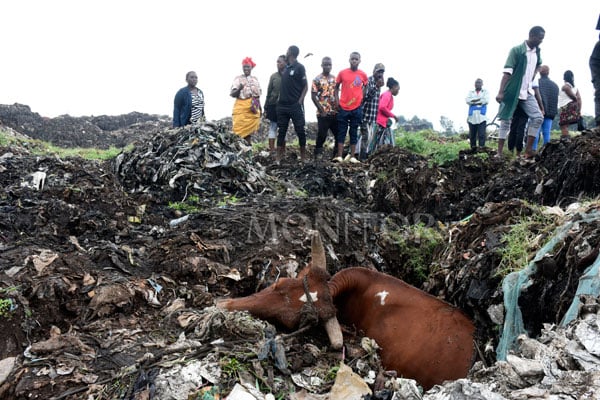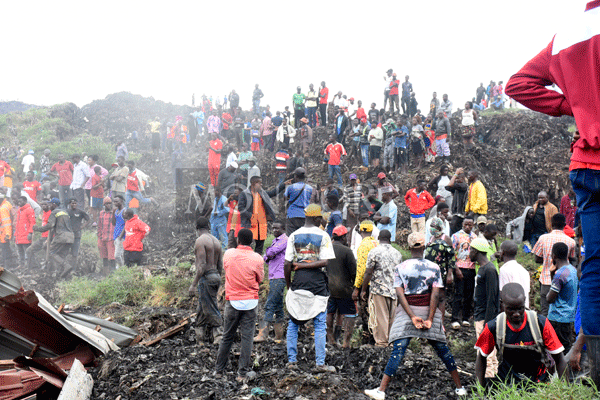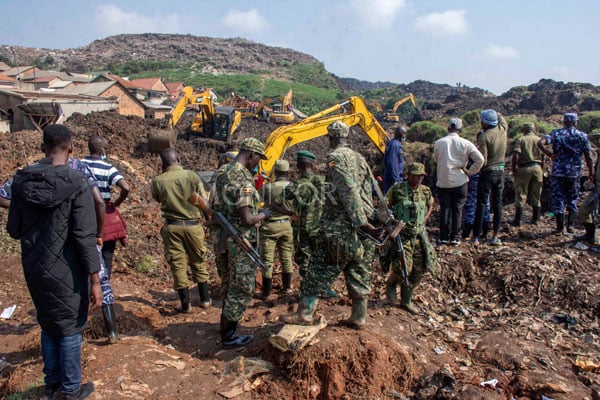
A tent that has been set up to accommodate the displaced people at Kiteezi landfill. Photo/ STEPHEN OTAGE
The alarm bells had been ringing since 2015 when the Kiteezi landfill should have been closed but were largely ignored until houses were buried on Saturday morning.
Kiteezi landfill was opened in 1996, first as a small dump site. In 2001, the landfill was upgraded to an engineered facility, and according to the engineering design, by 2015, the landfill had already reached its capacity and should have been closed.
Kampala Lord Mayor Erias Lukwago yesterday called for prosecution of the city leaders and other government officials whom he accused of negligence leading to the Friday tragedy.
“It is clear, negligence, recklessness, and insolence on the part of the sitting government. Some individuals should be indicted, and prosecuted for this mess because this is a criminal,” he said.
Dr Kizza Besigye, the former Forum for Democratic Change party president, on Saturday said the government was aware of the impending disaster at the landfill nine years ago but did not act.
“A ‘mountain’ of garbage moved to bury houses below and spread to contaminate a wide area! Expectedly, there won’t be any consequences for those who manage or mismanage this site,” he warned.
Mr Frank Muramuzi, the executive director of the National Association of Professional Environmentalists, told this publication that those charged with the responsibilities of managing the city and the environment should have known better that this would soon happen.
“They didn’t do anything to advise or evict or even to compensate the people around that place. They have a minister, a council, an executive director and parliamentarians. You cannot have a hill or a mountain, which is not grounded, which is not together in terms of soil, that was just created and you knew what would happen,” he said.
Uganda Law Society (ULS) president Bernard Oundo said the tragedy highlights a grave failure in urban planning and governance.
“Despite the government acquiring 135 acres in Dundu, Mukono, for the relocation of the landfill in 2015, the relocation is said to have been delayed due to budget constraints. The government has a responsibility to protect its citizens, and this includes ensuring that they have access to safe living conditions,” he said in a statement.
A 2021 Kiteezi Landfill Closure Environmental and Social Impact Assessment report indicates that KCCA intends to transform the area into a green space, including the use of methane to generate electricity.
However, reports from the KCCA indicate that the government failed to allocate funds for the decommissioning of the landfill.
However, State Minister for Finance (General Duties) Henry Musasizi yesterday said he wasn’t aware that KCCA requested such kind of money.
Ms Dorothy Kisaka, the executive director of KCCA, had told this publication that all communications regarding the Kiteezi crisis should be channelled to Mr Daniel Nuwabine, the director for corporate affairs. However, by press time, Mr Nuwabine had not responded to our repeated calls.
In 2016, KCCA bought 135 acres land at Dundu in Mukono District for Shs4.3 billion to construct a better waste management plant.
Ms Kisaka said while the land at Dundu was already paid for, the locals went to court, delaying the process of constructing the new facility.
She also said as a temporary measure, they have decided that they will create a buffer zone of 200 meters around the dump site.
“So everybody who is within 200 meters of the dump site, after the landfill, should vacate. We are putting a red line of 200 meters as a minimum level...,” she said.



